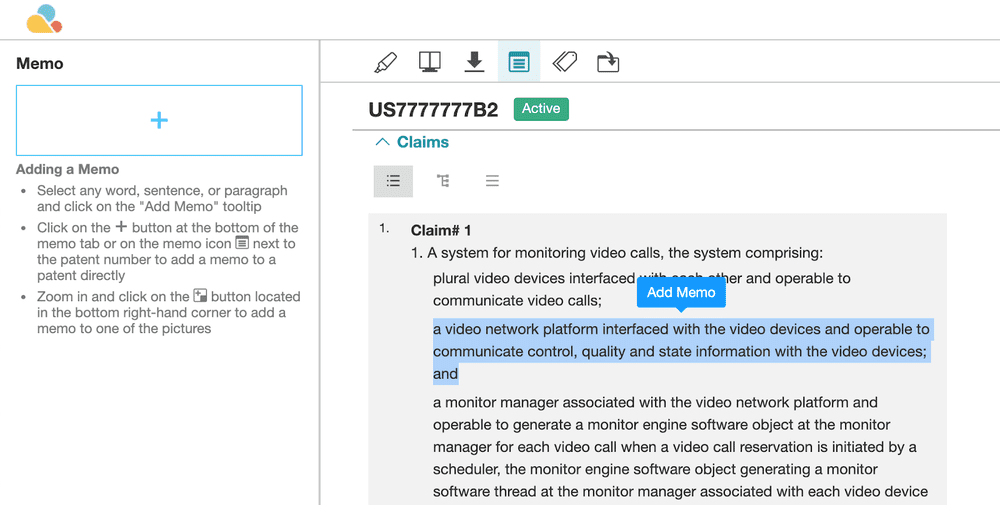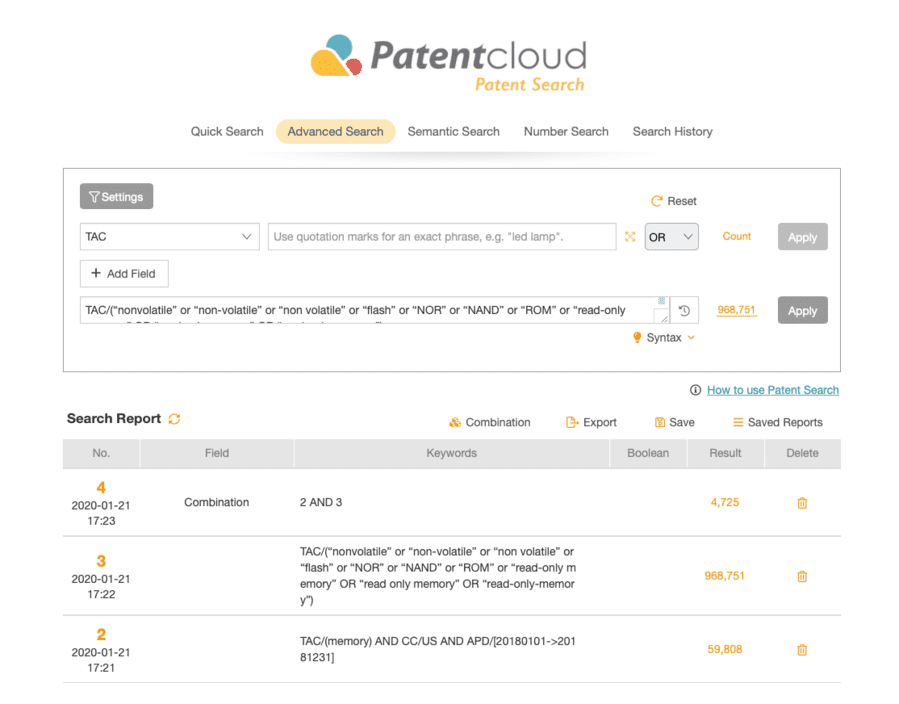Table of contents
- The Essentials of Patent Portfolio Management
- Enter Patent Lifecycle Management (PLCM)
- Competitive Analysis Is a Must
- Effective Management Tools and Solutions Are the Keys
- Conclusion
The Essentials of Patent Portfolio Management
Analysis
It’s now time to define what “patent portfolio management” really is. When it comes to the concept of patent portfolio management, knowing how to analyze patent assets is essential.
First, “technology structure,” “product structure,” and “field of applications” form the core of patent portfolio management analysis. In specific, any analytics should be based on these three dimensions in order to obtain comprehensive results.
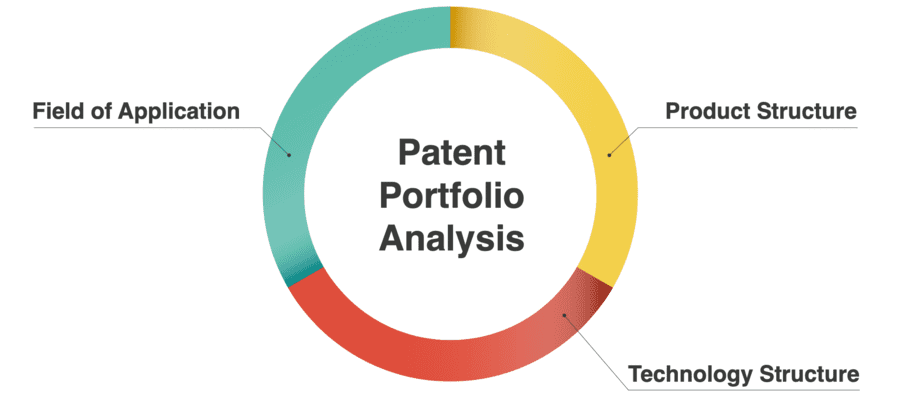
Generally speaking, when a technology is developed, it aims to cover a number of target fields of application. As a result, when a patent application is filed, it is necessary to consider how to protect the invention and its fields of application through the patent specification and claims.
A patent in whole is a combination of claims—so, when conducting any analysis, we should take a closer look at each independent claim. Since an independent claim itself represents a target field of application, this kind of examination can assist in finding out the technical solutions of each invention and discovering the biggest benefit it brings.
Is it the most cost-effective solution? Is it the top-performance method? Does it result in a higher yield rate?
By understanding the essentials of the patent via a thorough claims analysis, we can start to see patent portfolio management from a larger perspective.
Data Grouping
In order to expand a patent portfolio analysis based on the three-pillar structure seen above, we need to categorize the patents into different technologies, products, or fields of application.
To illustrate this point, we can examine a few of the analyses that have been conducted by our partner WISPRO. The first focuses on electric bicycle patents filed at the EPO.
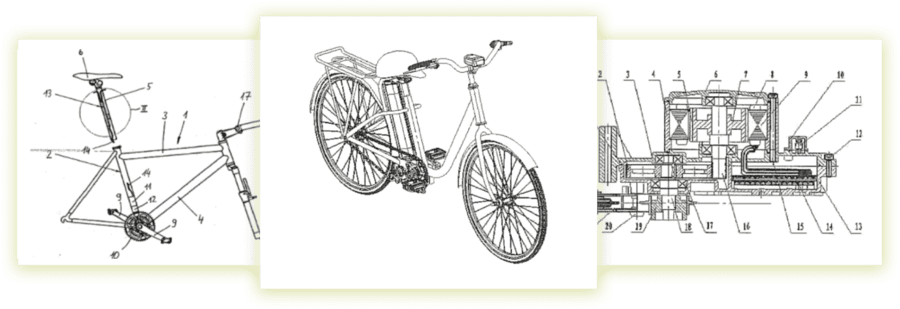
In this specific analysis, the patents are grouped by both product structure and technology structure. From a product perspective, WISPRO’s experts virtually tore down this product and divided it into smaller subsystems, such as the electric system, the computing system, the brake system, the suspension system, and so on.

As for the technology structure, the patents were categorized according to the technologies that they presented or disclosed, such as the technology behind the batteries, motors, sensors, materials, interfaces, among many others. By analyzing these patents through different perspectives, the overall evaluation of the patent portfolio can become much easier.
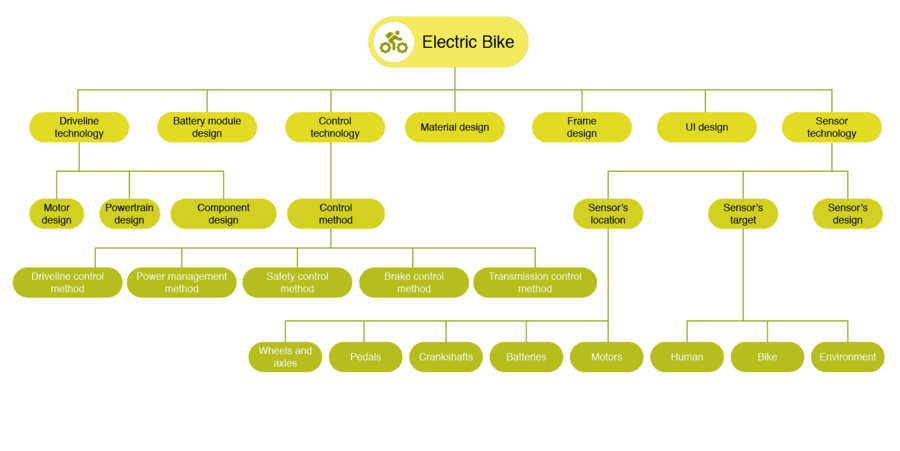
As mentioned earlier, analyzing the patents by taking a thorough look at their independent claims is highly suggested. In fact, while doing so, we may discover that a claim contributes to more than one category in the product structure or technology structure, which is actually quite common in this kind of analysis.
Another important aspect that should be mentioned is that by operating in this way, it will be easier to confirm the patent’s subject matter, which may be a method of manufacture or an object.
After the categorization has been completed, it can be visualized by utilizing the Patent Matrix dashboard. The visualization options available for this specific case are as follows:
Product vs. Technology—By reviewing the Product vs. Technology Patent Matrix, we can observe the distribution of the patents in this industry. We can also see what kind of product is protected with the largest amount of patents.

Technology vs. Technology—By reviewing the Technology vs. Technology Patent Matrix, we can identify which technology is more relevant to another technology, which may be the core competence in this field.

The second report features patents related to high-entropy alloys (HEAs), which are a type of alloy formed by mixing equal or relatively large proportions of (usually) five or more elements. As a side note, even though they have been studied since the 1980s, they really only began to be developed substantially over the last decade.

After making a categorization in a similar manner as above for the technologies involved in this field and the possible field of applications of the final products, we can transfer this data into a Technology vs. Fields of Application Patent Matrix dashboard.

This type of data visualization enables us to identify which applications might have been overlooked for a given technology, thereby highlighting and opening up potentially profitable opportunities.
Enter Patent Lifecycle Management (PLCM)
It’s now time to introduce the concept of Patent Lifecycle Management (PLCM). As we mentioned before, patent portfolio management is not a one-off business, but instead a series of actions that follow one after another on a long-term basis.
The totality of the operations carried out across the lifespan of a patent, from preparation to filing, patent prosecution, office actions, issuance, maintenance, and post-grant monetization, are collectively called “patent lifecycle management.”

Besides the three dimensions shown in the image above, we should further observe patent deployment from different viewpoints, with other factors like production, sales, competitors, legal status, application year, and deployed countries taken into account.
These factors, combined with the different stages of the patent lifecycle, help us to establish the whole patent portfolio picture, enabling us to examine an entity’s action at a specific point in time, together with its current patent landscape.
Most importantly, we can form our own business strategy—as well as our product strategy— right at the beginning of the lifecycle; we can prioritize the resources needed for the research and development (R&D) stage and target the right market segment before product development even starts.
Furthermore, we can think about a patent filing strategy alongside product development, and we can even consider how to commercialize and/or monetize the patent portfolio after the patents have been granted.
Competitive Analysis Is a Must
A good strategy also includes the observation of competitors’ patent portfolios in order to assess the level and number of quality patents they have, which, in turn, enables a better understanding of their—and perhaps even more importantly, one’s own company’s—position within the global landscape.
Without this comparison, it would be difficult to ascertain the true strength or weakness of a company’s patent portfolio, which could contribute to the risk of potential decision-making opportunities for the organization being overlooked as a result.
Here are a couple of tips to assist in conducting an effective competitive analysis:
- Monitor the patent portfolios of all the players in the market—With this information, you will be able to distinguish who the major competitors are and who the possible partners might be. Besides business decisions, you can also decide what kind of product or technology strategy to adopt, such as whether to increase investment in R&D or simply avoid such competition;
- Closely follow any updates—Since strategies are dynamic, everything can change over time. For example, your competitors may introduce new inventions from time to time, or perhaps some of their patents might be abandoned during prosecution. Whatever the case is, you should stay abreast of these changes on a constant basis in order to be able to respond accordingly.
Effective Management Tools and Solutions Are the Keys
Without the appropriate tools or solutions, patent portfolio management and even patent competitive intelligence will likely be inefficient. Unfortunately, the most common Intellectual Property Management Systems (IPMSs) today fail at addressing the above-mentioned key points, mainly due to two critical factors: non-searchable data and a lack of competitive analysis data.
Therefore, in order to effectively manage a patent portfolio or conduct a competitive analysis, we should take the following factors into consideration when selecting a tool or solution:
- It should let stakeholders share their ideas and collaborate with others in one space. This is important in eliminating the friction that results from switching from one tool to another and in enhancing communication within the company;
- It should be able to digitize all data fields and documents. For example, file wrappers are usually not searchable, making it difficult and time-consuming for patent professionals to extract useful information from them. With the help of technologies such as Optical Character Recognition (OCR), however, this information can become searchable, and large amounts of patent data can be handled more efficiently;
- It should give users the option to conduct instant—and in-depth—analysis. As patent data continues to become easier to be managed, it will also become increasingly common for key insights to become available in just seconds. With the help of artificial intelligence (AI) and the accumulated experience of patent professionals in relevant industries, obtaining instant, in-depth analyses from large amounts of patent data should soon become the standard for patent tools and solutions.
Dynamic Adjustments According to Corporate Strategy
It should be noted that patent portfolio management isn’t an absolute concept, nor is it a standard process with predefined steps to follow. Instead, it’s a series of actions that heavily depends on the true needs of a business.
After conducting a competitive analysis, you may find out that your portfolio is missing something and, consequently, activate different operations, such as buying or selling, pledging, licensing, commercialization, investment, M&A, or enforcement.
You may also change your strategy as time goes by or as the business direction changes. For example, if it is noticed that a company has suddenly stopped applying for patents in a specific technology, possible commercialization issues with the technology may start to be investigated, and a company’s development strategy may be adjusted accordingly.
How Patentcloud Can Help You with Patent Portfolio Management
- Patent Vault: A Collaborative Workspace
Patent Vault is a collaborative workspace that enables patent professionals and inventors to work together. Its project-based, customizable folder system enables both parties to effectively manage and categorize patent portfolios according to their preferences, which is something that is necessary for effective patent portfolio management.
What’s more, Patent Vault’s auto-monitoring feature allows all involved stakeholders to receive alerts whenever the patent’s legal status changes or the search results of a given query change, enabling real-time monitoring.
In addition, Patent Vault’s wide range of other features enables users to work with others and share ideas seamlessly, breaking down the siloed communications practices of the past. - The Patent Matrix: Patent Analysis in Multiple Dimensions
Besides cross-domain knowledge and the PLCM concept, a robust, specialized tool like the Patent Matrix is also a must. Patent Vault’s Patent Matrix dashboard is designed to enable patent professionals to analyze patent portfolios from a broad perspective by tackling the complexity of analyses involving technology, products, and fields of application structures.
With the Patent Matrix, patents’ product-to-technology structure relationship, technology to the field of application relationship, and fields of application to product structure relationship can be analyzed within customizable two-level matrices. - The Search Feature: Find Exactly What You’re Looking for in Seconds
With so much data available to be added into an analysis, it only makes sense that a search feature should be embedded into the product as well. All of the data collected in Patentcloud is searchable, ranging from bibliographic data to file wrapper documents. The aim is to streamline the patent data processing stage, making it easier for patent professionals to organize, manage, and analyze patent portfolios. - Due Diligence: Quick and Effective Patent Portfolio Evaluation
With Due Diligence, you can access a variety of dashboards to dig out validity issues or monetization opportunities, all while conducting a competitive analysis. This solution not only benefits those who work in patent portfolio management, but also those who operate in patent transaction, licensing, and pledging.
In particular, the Quality Highlights dashboard can highlight all potential patentability, novelty, non-obviousness, and indefiniteness issues in a portfolio. This is useful for both patent sellers—to examine their own assets and evaluate which patents should be put into the market first—and patent buyers, who can use this dashboard to uncover potential issues for future enforcement.
Conclusion
It should be clear by now that the traditional way of dealing with patents—that is, regarding them as inventory instead of as a revenue opportunity—simply isn’t sufficient in today’s patent ecosystem.
What is needed are patent professionals with knowledge from a wide array of domains, a solid background in patent law, and the ability to bring together talent from different departments of a company. This would help in tackling one of the biggest problems in traditional patent portfolio management: siloed departments.
We have also seen that patent portfolio management doesn’t end up with the granting of a patent, or with any of the individual steps leading to this.
To successfully manage—and ultimately monetize patent assets—what is needed are flexible systems and approaches, such as Patent Lifecycle Management (PLCM).
This approach to patent management and monetization takes into account all of the stages of a patent’s lifecycle and even goes well beyond this. In fact, PLCM also takes into consideration the position of the company within the market and in comparison to competitors, providing a snapshot of the current situation, including both its issues and opportunities.
A strong emphasis on competitive analysis allows stakeholders to align the portfolio strategy to the changes in the market in a timely and effective manner, enabling the efficient allocation of resources while avoiding wasted time.
Even the best management system, however, won’t deliver the desired results if it is not coupled with robust tools. That’s why we have introduced Patentcloud, an IP intelligence platform that handles every aspect of PLCM while bringing together all of the stakeholders involved.
To learn more about Patentcloud, visit its official page and get ready to start improving your patent strategy today!



